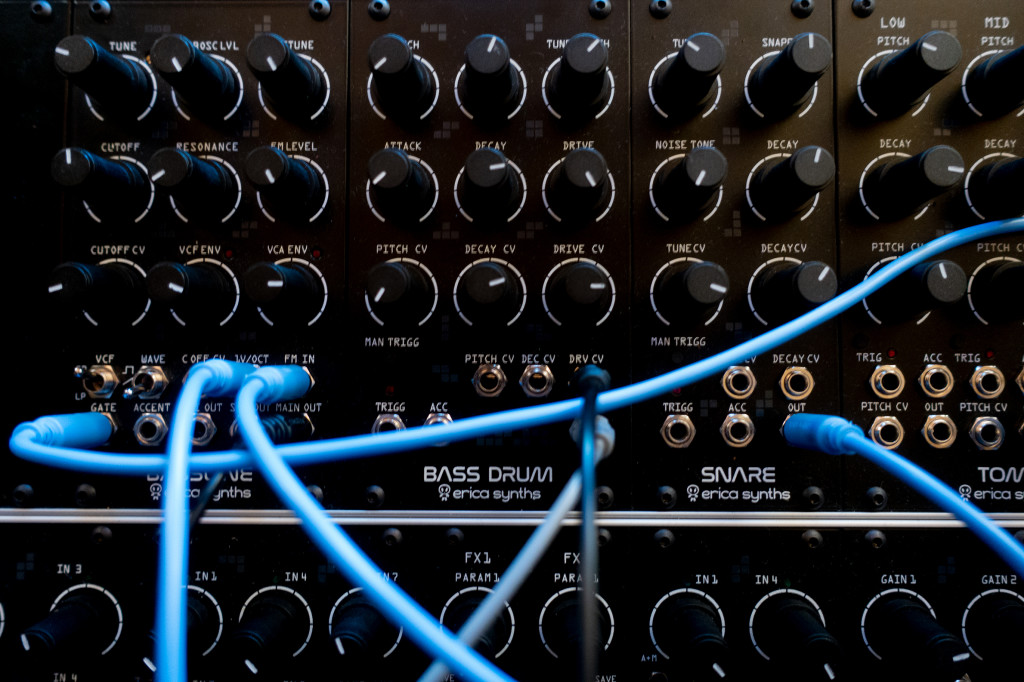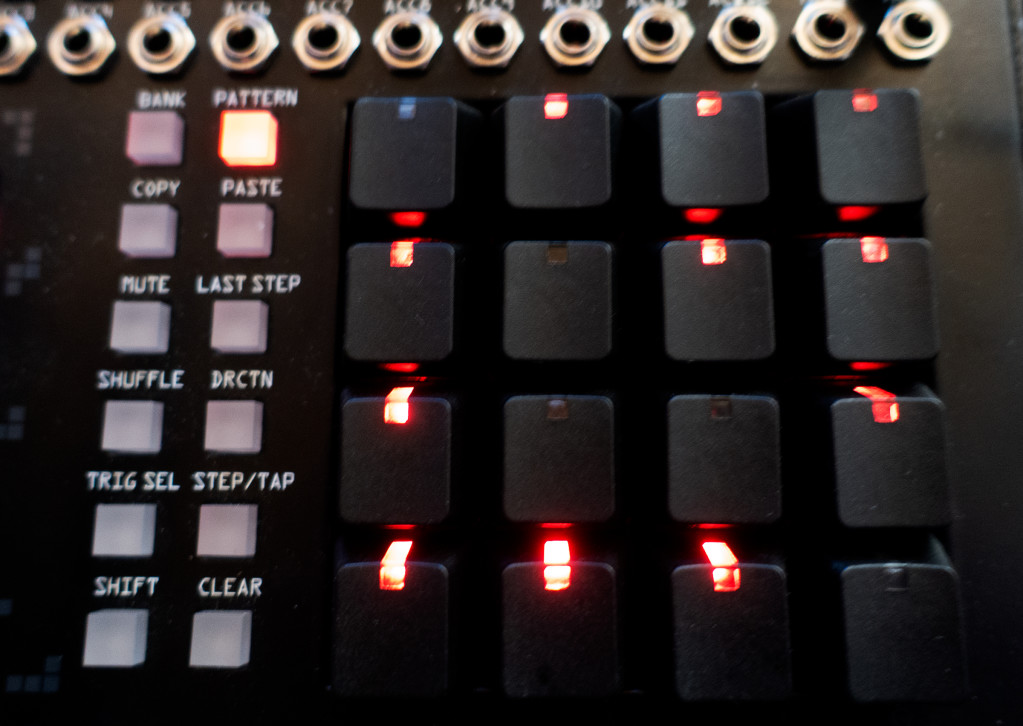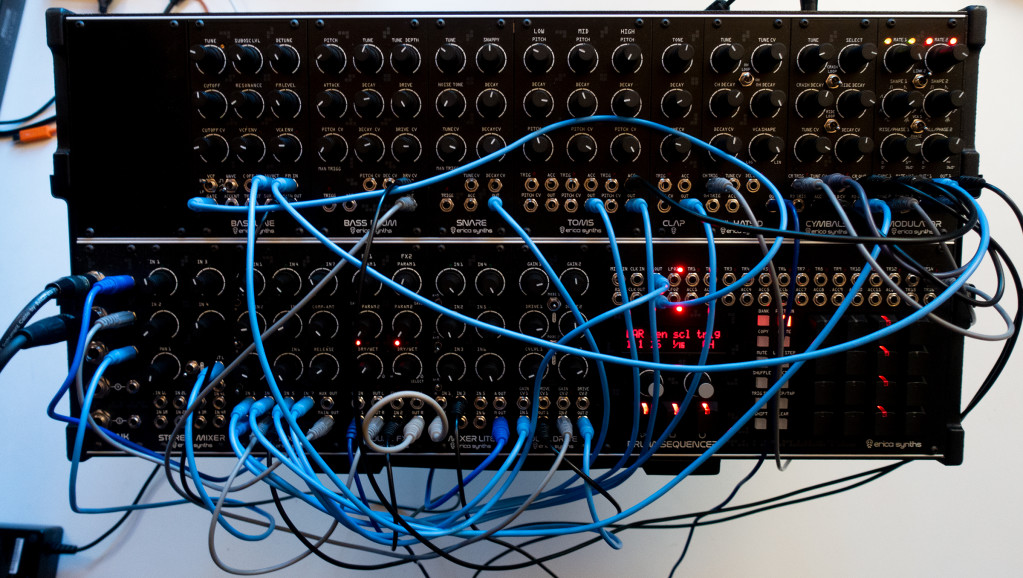The modular world is replete with ideas – but what would a complete modular concept look like? Erica Synths’ Techno System is just that rare kind of concept, a modular made for dancefloors rather than chin scratching, and a total vision instead of just components parts. So we thought it deserved a proper techno test drive.
The modular for techno
We’re one year following the debut of the Techno System at last year’s Superbooth show in Berlin. But with this year’s edition having brought still a fresh avalanche of gear – from Erica, alone – now seems the perfect time to take a step back.
To give Techno System a proper run, I teamed up with producer Jamaica Suk. Apart from running her own label Gradient, Jamaica is a rising star on the techno scene, as well as a resident of the impossibly hot Pornceptual queer party series. (Full disclosure: we also share a studio. Pornceptual for its part is hot enough that its Boiler Room wound up – no joke – on Pornhub after YouTube dropped it.)
The Techno System is a Eurorack modular, so it’s both a complete system you can buy in a case – that’s what we tested – and a set of modules. That is, you may not personally drop four grand on this full rig, but at the same time, the Techno System itself serves as a nice demo for all the individual modules inside.
Making a “Techno System” isn’t just a marketing ploy. Techno – and related industrial and EBM sounds – can be safely said to be a big driver behind the growth of modular. The days of modular just being about noodling and chin scratching are over; these machines pound dance floors and top charts. And while DJs now turn up to gigs with just USB sticks, the pro techno circuit, particularly around Europe, is such that it makes sense at a certain point to graduate to using something that feels like a real instrument.
So, yeah, the elephant in the room – the Techno System definitely isn’t cheap, at about four grand for the full system. That’s a steep ask compared to desktop, though as Jamaica pointed out to me, it compares favorably to the cost of building your own rig – often winding up without something that’s terribly usable. And it is something some artists, at least, will pay off by gigging with the machine.
For Jamaica, that meant even a small skiff full of modules already cost about half the price of Techno System on its own. And Erica’s hardware offers an escape from her previous hardware workflow – doing a lot of menu diving. (Jamaica compared the experience to the menu-oriented work she does on Elektron gear.) The only menu on the Erica rack is on the Drum Sequencer; this rack is bestrewn with knobs. And it’s covered with patch points, meaning you can make sounds that are dynamic and organic and weird and unexpected.
So let’s see if this system can live up to its aspirations – and if there are individual modules you should watch out for onboard, too.
To set the mood, here’s a jam on the system as Jamaica and I were hanging out in the studio with it. (My arms, in case the hair didn’t give that away.) Mayhem and destruction? Oh, yes, indeed. Expect more; I was quickly filling up my drive with song ideas. Maybe I’ll put them out under a psuedonym. “DEATHBL0GG3R?” “D0RKDUSTRIAL?” No?
A complete system
The Techno System is a set of modules for “rhythm based music production” – think techno instrumentation, but of course what you do with it is up to you. On the surface, it seems fairly obvious: you get a bass module, percussion parts (kick drum, snare, toms, clap, hats, cymbals). There are processors (two-in-one effects, two-in-one drive). And there’s stuff to compose and put this all together: a modulator, an expansive sequencer, mixers, and jacks to the outside world.
As you’d expect at this price, you get everything – a handy patch book and user manual, a bunch of nice patch cords, the power supply, and a lovely rugged case. (You have to pay extra for a leather strap; we left that bit out.) The case is solid and surprisingly luggable – you could absolutely take this as a carry on and tour with it. (For the love of God, avoid checked luggage.)
The thing is, that description sounds vanilla – and this beast is the opposite of vanilla. Latvian builder Erica have imbued this with their usual, raunchy, violent post-Soviet sound aesthetic. There’s just a whole lot of engineering detail here that gives this set up of modules its unique character.
And it’s clear straight away. The first time I saw it live, as sweaty Erica associate and Riga-based producer Kodek destroyed a dance floor with it. That’s not just to gush – there’s a specific reason Erica have gotten that sound. Module by module (and to be honest, I wound up looking at this after playing with it – as in “why the heck does it sound this crazy, anyway?):
Bassline. This module to me is the star. The oscillator is a newly remade version of Doug Curtis’ legendary CEM3340 analog oscillator – the sound you know from classic Oberheim, Korg Mono/Poly and Poly- synths, Roland SH-101 and Jupiter-6, and many others. Instead of using someone else’s clone, though, Erica work with Riga’s own Alfa, who have been manufacturing their own version in Latvia.
Erica’s stroke of genius here is combining that three-waveform oscillator with a transitor-based sub-oscillator for more bass, plus their ultra-violent Acidbox-style filter, plus a detune that’s actually not a detune but two bucket brigade delays acting like one. What you get from that potent brew is leads and basslines that can go full spectrum from melody to noise, and a filter/detune combination that makes it absolutely punch people in the gut. And it makes perfect sense in a modular, because all that insanity lends itself to patching, from the frequency modulation input to modulating the filter.
I should, like, talk about the rest of the modules, though.
Bass drum. I briefly mistyped “ass drum.” Freudian slip. Yes, this will give you classic kick sounds. Again, though, Erica worked a ton of magic here – the tune depth and tune controls are immensely satisfying, you get a Drive in case this thing isn’t dirty enough for you, and ample CV.
Snare. The Snare is probably the unsung hero of this rack – Jamaica has taken to using it even for hats. So even though Erica call this “909-inspired,” the fun is really making full use of the Noise Tone and “Snappy” control and patching in CV, which makes this more of an all-purpose percussion module.
Toms, Clap. The Toms and Clap are actually the only particularly vanilla modules here – they’re conventional toms and clap circuits, just with loads of patchability, including on accents. But that’s the advantage here of buying a modular – you don’t have to leave these in their normalled behavior. Both sound great; I just wish the Toms had some more control or variety, maybe more a complaint about analog toms generally. (Decay is 370ms – 955ms, which in practice means you don’t touch that knob much.) As set it and forget it modules, though, they’re great.
Hi-Hats D, Cymbals. These are PCM-based, but they’re run through a voltage-controlled amplifier that again have that snappy, aggressive Erica envelope sound. This time, Erica work again with Latvian maker Alfar for their version of the 3330 VCA chip – and then add their “I’m at a sweaty warehouse rave” envelopes to them. (Maybe I’m projecting.) If you leave these normaled and don’t dig into them, they also could go a little vanilla. But there’s a twist on each. The hats module will loop open hi hats, which can almost sound like a unique decay. The cymbals have ten custom crash and ride samples – and combined with CV patching and decay controls, just as with the snare, you can abuse the cymbals module into stuff that sounds nothing like a ride.
Sample Drum. We actually got our Techno System delivered without the Sample Drum, but it’s a worthy module inside or outside this system – a pretty essential implementation of sample playback in a Eurorack format. There is a hole for it in our system… but more than that, the Sample Drum is a place you can augment the unique Erica sound with additional sounds of your own, obviously.
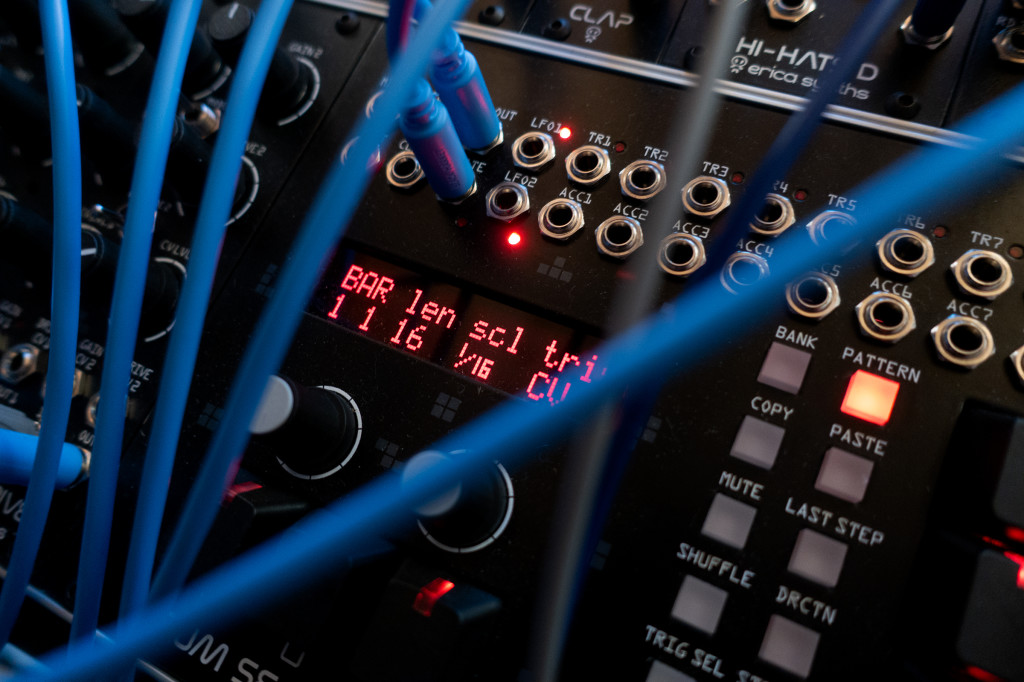
The sequencer acts as heart of the system – with quick-to-access controls by push encoders and buttons, and lots of patch points.
Sequencing and workflow
So that covers sound – and you could actually just pick your favorite modules and drop them into a rack. But the system part of the Techno System is really about combining the sound engine with modulation, mixing, and sequencing in a coherent way.
The Drum Sequencer is normalled to the percussion parts inside the rack, so while you can re-patch triggers, you can very quickly punch up a drum pattern quickly.
Drum Sequencer. One Erica idea I wish I had thought of – the sequencer uses a numeric keypad that feels like a classic IBM keyboard, with LED indicators behind – instant 4×4 grid. No velocity sensitivity, but that’s not really what this brutal machine is about, anyway. Everything else is select-able via some (mostly) intuitive trigger buttons and two push encoders. Once you squint your way through the included manual, you’ll find working is really quick, with all the expected basic figures – set last step per part for basic polyrhythms, set sequence play modes (back/forwards/pingpong/random), copy, mute, and string together multiple patterns.
So far, that sounds like a conventional sequencer, but the Drum Sequencer’s modular side gives you 16 full dedicated triggers, and 12 accents. The accents are really what it’s about when it comes to making more dynamic productions – enough so that Erica even implore you in the documentation not to forget them.
There’s also a dedicated CV/gate track. You can map pitch to one of a set of fixed scales and modes, then dial in or play melodies with gate. That could serve as a melody for the Bassline, or something else. (Sometimes I found myself using the Modulator for the Bassline CV in, instead.)
Erica have also included two LFOs on this module, which augment the LFO outputs on the Modulator module. These LFOs are optionally tempo-synced, so you can quickly generate rhythmic LFOs directly from the sequencer. It’s hidden in some menus behind the encoders.
Having all those triggers makes sense if that’s what you’re looking for from the Drum Sequencer in a larger modular rig, but it feels a little unbalanced in the context of the Techno System. I would gladly sacrifice a few of those sixteen triggers and twelve accents for even one more CV/gate track or another LFO, for instance.
Overall, though, working in this unit is terrifically fast and enjoyable.
Erica have done a lot with the hardware since its release, too, adding more musical features (like CV slide, gate tie, song mode, auto copy bars, and more), plus tons of fixes. Check the full changelog:
https://www.ericasynths.lv/news/drum-sequencer-update-changelog/
Modulator. This module is totally essential – otherwise you wouldn’t want a modular system like this in the first place. There are two independent LFOs with morphable shape (including noise waveforms) and phase / rise / envelope controls. You can sync them from an external clock – here, that means probably patching the Drum Sequencer into them – in which case the rate controls divide or multiply the clock signal. Or you can run them free, though I long a bit for a switch to give me different ranges. Cleverly there are both outputs and phase-shifted outputs for each LFO, and you can link LFO2 to LFO1 but still use the rate knob as a divider.
Probably the confusing element of this is the triple-function RISE/PHASE control, which determines envelope fall time, and phase shift, and filter cutoff. (Actually, it’s even quadruple-function, since there’s both a lowpass- and highpass-filter.) But in practice, part of the pleasure of those knobs is to stop worrying and experiment, anyway, so they’ve been arranged in a way to encourage some intuition.
Dual Drive. You want more distortion? You get more distortion – three additional flavors of overdrive, in each of two independent circuits, with really flexible patching. If you haven’t gotten it yet, yes, Erica are all about industrial, distorted, concrete-shaking sounds. “Dual” is right, too – if you don’t patch the second input, the two distortions will operate in series. (Hey, dawg, I heard you like distortion…)
Dual FX. This is a wildly powerful effect, but here I do wish we got a small OLED – its power is largely hidden. A push encoder hides different delays (mono/stereo/high-pass), reverb, still another distortion called Ripper, plus a unique dual pitch shifter. There’s also a save function so you can store parameters with each effect. The effect sounds fantastic, but is also fantastically confusing – Erica’s only feedback is in binary on the LEDs.
The Dual FX’s saving grace is that it sounds like some very expensive effects, even though inside is the fairly conventional Spin FV-1 digital chip. And you do get two patchable CV inputs. But I think this particular module is due for some rethinking. That may be partly my own bias – I think the whole point of hardware modular ought to be giving us intuitive hands-on control, not taking away useful visual feedback from digital hardware and software.
Mixers. Rounding out the Techno System are some terrifically useful mixers – and if Erica show off their approach to aggressive envelopes and raunchy sound on that side, here they show they can also make things functional and practical. At first, it seems a bit odd that you get a stereo mixer, a 7-input Drum Mixer, and a 6-input “Mixer Lite.” But in practice, the arrangement adapts itself to a variety of use cases.
The 7-input Drum Mixer neatly pulls together a percussion grouping, with vactrol-based compressor on each for still more punch. And you can send to mains or aux sends. The Mixer Lite gives you more or less the same idea in a more compact 6-input version.
The Stereo Mixer, as advertised, lets you position across a stereo field but also includes flexible routing and internal limiting.
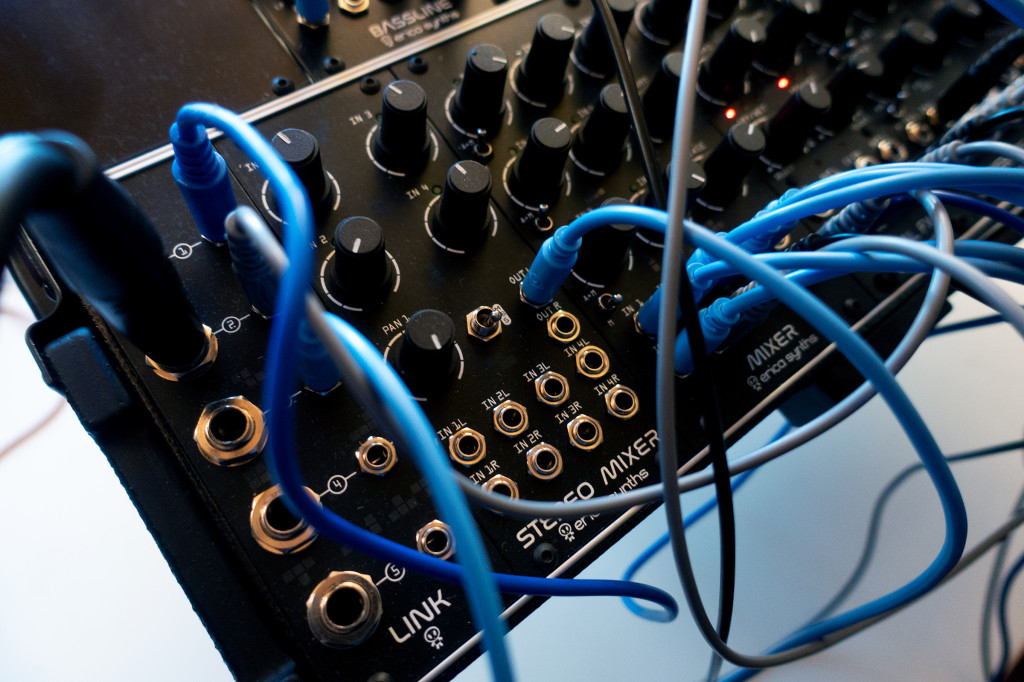
Multiple modules for mixing and routing help you integrate the Techno System with the rest of your studio or live rig.
The result of all of this is, you can easily compose a mix of percussion both when it comes to live performance and production. Actually, maybe it’s telling even that both Jamaica and I liked it. She had a setup that worked well for her largely outboard, hardware-based setup; I had configurations that worked well for composing in the box in the computer and making stems. And when we wanted to jam live, the separate mixers worked well, too.
Really, the only challenge is working out whether you want to rearrange them in the rack, as the mixing component is where you tend to wind up with a bunch of cable spaghetti. So I do wish here Erica had normaled outputs as they did with the sequencer, and then just let you override that behavior.
But at the very least, if it looks like Erica just filled out a rack with every mixer module they make (which honestly was kind of my kneejerk first impression), that’s not the case at all; this grouping makes loads of sense.
The outside world. I expect a lot of people will use this rack alongside a computer, so it’s worth noting: the Drum Sequencer has a MIDI input, which you can use for clock. That saves you a more expensive arrangement. The Link module also provides convenient full-sized jacks which attenuates outbound signal.
In use
A modular system that already has ideas about how it’s going to be used may sound like an anachronism. But in practice, it’s anything but. There’s a natural workflow here. Punch in rhythms on the Drum Sequencer, reroute some accent tracks and triggers to add some spice. Wire the Modulator into FM on the Bassline and dial in unruly timbres, then tune the filter envelope so it’s banging up against the drums. Add drive and effects to the percussion until it sounds dangerous.
Part of what I think makes Erica special is that they come out of a particular context – both engineering and musical. The engineering has grown out of the legacy left behind in one of the USSR’s former major manufacturing hubs, the city where a lot of Communist-era noisemakers were fashioned. And they’ve connected to the grimy, industrial warehouse-friendly music weirdos of the former east, too and … well, all of those of us with similar natural tendencies. They sit at that essential overlap of engineering and sound practice.
So I do recommend getting to hear a Techno System whether or not you’re even going to buy one. The sum of these parts really is something greater – this thing hums and breathes and growls and bangs around and spits out big bursts of noise like clouds of exhaust. Sometimes we wound up recording random accidents that came out when we stopped the transport. This is one of those pieces that feels alive.
While I focused on sound, Jamaica focused on ergonomics. Trouble with repetitive stress makes it hard to use the computer for long periods of time – and even hardware menus can be painful, literally. She says that the Techno System has helped her work more comfortably, and that means more musical productivity.
Conclusions
The Techno System is a luxury item, without question. I am happy that one has taken up residence in our studio. (Thanks, Jamaica.) If you want a complete vision of percussion, modulation, sequencing, and a killer bass, and this is in your budget, it’s a beautiful choice. And of course we’re not in an outrageous price range for something you plan to make an instrument.
Just as important, the Techno System represents a lens on how a modular rig can be coherent, and can offer some new ideas. And it can apply to a popular genre, not just experimental ones.
I also think it’s worth really endorsing some of the modules inside – which proves the idea that a great way to sell individual modules is to give them a larger context. (That’s something Erica has done in a way few others have – other than those largely echoing historical systems.) I wouldn’t mind seeing more of these in desktop form, too, which knowing Erica may be possible.
The Bassline is simply genius. I’d buy a small skiff just to work with it. The Dual Drive also is a convenient way to add signature Erica distortion. And my gripes about programming Dual FX aside, there really isn’t a single dud in the group.
That said, of course working with modular comes at a cost. I think software and desktop systems should continue to push this kinds of hand-on control, but apply modularity that copies this accessibility without the wires. (Yes, they still get tangled and you still wind up with the wrong lengths.)
So can you use cheaper gear, software, non-modular stuff, battery-powered stuff? Of course! And some of us really should keep going that route. What’s comforting about the Techno System is, it proves the modular route is also staking out sound, personality, and utility all its own. It’s not just gear fetish. Whether you buy this rack or not, anyone who loves sound is likely to appreciate the very fact that it exists. And that’s a good sign for our maturing music tech scene.
More videos…
Still want more? Check these:
A terrific sound demo from Erica that really represents the system nicely:
We didn’t yet get to fully test the Sample Drum module that has now been added to the Techno System – but first impressions are great. Here’s a walkthrough:
And while it’s the earlier revision of the rig, you get a full-on extended jam from Erica’s “garage” streaming:
https://www.ericasynths.lv/shop/eurorack-systems/techno-system/
